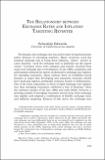Mostrar el registro sencillo del ítem
The relationship between exchange rates and inflation targeting revisited
| dc.contributor.author | Edwards, Sebastián, 1953- | |
| dc.date.accessioned | 2019-11-01T00:03:37Z | |
| dc.date.available | 2019-11-01T00:03:37Z | |
| dc.date.issued | 2007 | |
| dc.identifier.isbn | 978-956-7421-28-2 | |
| dc.identifier.uri | https://hdl.handle.net/20.500.12580/3726 | |
| dc.description | For decades, the exchange rate was at the center of macroeconomic policy debates in emerging markets. Many countries used the nominal exchange rate to bring down inflation, –others—mostly in Latin America—used the exchange rate to implicitly tax the export sector. Currency crises were common and usually resulted from acute real exchange rate overvaluation. In the 1990s, academics and policymakers debated the merits of alternative exchange rate regimes for emerging economies. Many authors drew on credibility-based theories to argue that developing and transition countries should have hard peg regimes, preferably currency boards or dollarization. One of the main arguments in favor of rigid exchange rate regimes was that emerging economies exhibited a fear of floating. After the currency crashes of the late 1990s and early 2000s, however, a growing number of emerging economies moved away from exchange rate rigidity and adopted a combination of flexible exchange rates and inflation targeting. | |
| dc.format | ||
| dc.format.extent | Sección o Parte de un Documento | |
| dc.format.medium | p. 373-413 | |
| dc.language.iso | eng | |
| dc.publisher | Banco Central de Chile | |
| dc.relation.ispartof | Series on Central Banking, Analysis, and Economic Policies, no. 11 | |
| dc.rights | Attribution-NonCommercial-NoDerivs 3.0 Chile | * |
| dc.rights.uri | http://creativecommons.org/licenses/by-nc-nd/3.0/cl/ | * |
| dc.subject | TIPO DE CAMBIO | es_ES |
| dc.subject | INFLACIÓN | es_ES |
| dc.subject | MACROECONOMÍA | es_ES |
| dc.title | The relationship between exchange rates and inflation targeting revisited | |
| dc.type.doc | Artículo | |
| dc.file.name | BCCh-sbc-v11-p373_413 |


